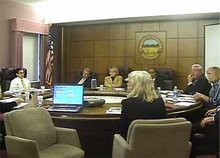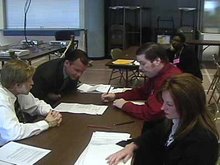Mr. Aldo Tesi, CEO of ES&S was there with his team; Mr. Gregg Burt, CEO of Hart, was there with his. The meeting proceeded mostly in the manner of the CCBOE asking a question, and then the two CEOs or a team member each took a turn answering.
This in many ways was an historic meeting for Cuyahoga.
The past board made their first "and firm" decision to buy Diebold touchscreens in Feb. '04, and continued "negotiations" in many executive sessions (where they kept the public in the hall for hours) and/or in some "public meetings" (which, in actuality, the public had no way of understanding the decisions were happening.)
The past board, rather than ask Diebold tough questions, or press Diebold into any compliance - even when they didn't fix their registration database that was deleting people and causing many errors; or didn't show up for a May train-the-trainer class; even when their $168/hour project manager did not come to board meetings, or when she came she had no answers (just more suggestions of more things to buy to remedy their past failures;) and even when their equipment was failing and falling in May '06 - the board refused to note failure rates; refused for two years to seriously listen to documentation about Diebold failures from across the U.S.; and even refused to let the public know when they were going to sign the unseen contract with Diebold, or how many pieces of equipment they were "firmly" planning to buy. (It was signed, unannounced, in private, on 11/11/05)
Instead, between May and November '06, in the face of (ignored and unadmitted) massive, poor direct experience, and massive numbers of very damning reports coming from scientists across the U.S. about Diebold, the board continued to listen to Diebold's "answers"; and at almost every board meeting, the board awarded Diebold another minimum $.5 million for senseless items, such as roll carts (with ignored very late delivery,) so the "fragile" machines would not break, privacy screens (like cardboard sunshields for car windows;) training (though Diebold failed at that in May, and Cuy. had already paid the Community College 3/4 of a million for training;) for 900 more machines - to (ahem....) back up the high number that were failing and breaking at the polls in May; etc.
The last evoting acquisition - for this past March - was a rather forced, and very (too) rapid one, with only one choice available, under the SoS's "firm" "preference," and old but current certification laws - the leasing of ES&S 's old, M650 central-count, non-digital scanners (the purchase of which, are part of the current ES&S proposal....)
This board did not have the time, space or alternatives to actually hold a vendor to more reasonable pricing, reasonable service ( the kind expected for a million dollars, not the kind we get because we pay them another almost another million for it, as happened in March '08,) reasonable warranties, etc.
This meeting is the first one that I've witnessed, certainly in Cuyahoga, where an elections board is actually doing due diligence for voters and taxpayers with elections equipment vendors - holding them to task, expecting "reasonable" (hard word to use in this context) pricing and service and warranties, putting forth penalties for non-performance, etc.
And if you watch the film below, you may agree with me that they are doing one heck of a good job! It was a pleasure to see that finally, someone is putting the small field of currently "certified" elections equipment vendors in their proper consumer company places - letting them know that a time of no choices, too little customer knowledge for "defense" etc. is fast closing, and they are not going to control a whole board, nor a whole county's elections and get paid exorbitant amounts for doing it.
Items on the table on 6/12 included such things as willingness to offer:
- a "Most Favored Nation" clause (the best price offered anywhere,) the duration of that clause, and what items and/or services it would cover (equipment, licenses tech services, etc.);
- locking in those prices and guarantees that they will be around to service the equipment for periods from 5 to 10 years; (Hart promised 10 years.)
- the ability and cost to other equipment if the CCBOE decided to use different ADA devices than those proposed (both ADA solutions comprise a large part of each bid, neither provides a really good and workable, secure solution for the CCBOE;
(Hart proposes their 33 lb. touchscreen, eSlate, large for Cuy. polls, at $2+M, possibly offering similar difficulties to poll workers as Diebold's Tsx's in set-up & coding the proper ballot, and found one of the most insecure parts of the Hart equipment in both the EVEREST Report and the CA Review.
ES&S proposes the 80lb. AutoMark for each poll, at $3+M, a paper ballot marking device, which to me is far too slow, (especially for a multi-page ballot, one page at a time, especially when a person cannot see who's looking at one already filled-in page while another is processing,) and still necessitates the disabled person getting to another scanner to cast the vote, etc.) - Comparisons of the digital technologies and the capacity abilities of the proposed digital scanners.
(Hart proposes their precinct digital eScans and central count BallotNow digital scanners for absentee votes.
ES&S proposes Cuy. start with non-digital technology, but optical scanners/tabulators, (M-100's at the precincts and the same 15 M650's already leased and at the board, for this past March) since their digital tech has not been certified yet. They also propose trading out the precinct optical scanners for digital, DS200's after they are certified - they say/we'll see... by November ('08.) Though they've spoken about their central (for absentee) digital scanners, (the DS2000s,) these, from what I can see, are not part of the bid. The big, 1950's tech, and what the ballot Administrator has termed "legacy equipment", the M650 optical scanners would stay.) - Delivery dates for November's election -
(Hart says by Aug. 31; ES&S says, if I remember correctly, by Sept 31.) - They hammered out who pays for the vendor's Performance Bond, and added and tried to firm the duration and amounts of Performance Guarantees.
(ES&S had Cuyahoga paying for their performance bond!) - Nailed down warranty language and asked questions about corporate viability
- They asked and compared Training services
- Ascertained such things as what it means if a vendor charges the client for installation and the client's Acceptance Testing of the vendor's equipment.
(Hart said that was a "cost of doing business" for them; ES&S hedged, and said those charges were a way of "recovering their costs." (I add, also a (paid-for) way to make sure their equipment gets "accepted" - a pretty good "gig" if one can get away with it.) - They covered some functionality issues, both with their own questions and those submitted from the public during the midway-thru, executive session/break;
- and much more.
The meeting ended with the plan that Cuyahoga would draft a contract for each company according to the oral representations made at the meeting (or answers yet to come,) submit each company's contract to them by June 18 for any further discussion to make it acceptable to both parties, and would make their decision at a public meeting at 5pm on Friday, June 20.
1. The meeting starts, introductions and opening statements are made, the framework is set:
2. Negotiating locking in the best prices, across the board, for years:
3. Discussion of delivery dates;ES&S promises to have their currently uncertified, digital precinct DS200's certified and in hand, as trade-in for the M100 optical scanners, for the May '09 election; guarantees for "glitch-free," "successful" performance/elections; and discussed corporate viability:
4. Discussion of printing costs; a break and "regrouping"; discussion of who pays for installation and does our acceptance testing, etc.:
5. More about warranties, guarantees, especially 3rd party warranties with Hart equipment, willingness to offer free back-up units for election day, who pays for the vendor's recertification if their products (so obviously) demand another look, etc. (Reposted clip with important audio throughout:)
6. Listen to this one about Training. Mr. Tesi explains that ES&S has separately owned training division. (And in the world of unfortunate names, election integrity activists have noted that the name of Premier's spokesman is Chris Riggall. The owner of the ES&S's training division is Colleen Haack.)
Eddie, the Hart training manager - a vendor! actually talks about "the sanctity of the vote!" (Hopefully that would translate to everyday usage.)
7. In this last clip they ask more functionality questions from public, and begin to summarize what was accomplished, and set out next steps.
(The reason the exportability of election results to a regular spreadsheet program is so important is for example, with ES&S 's 700+ page, 6pt. type, pdf report from Cuy.'s March '08 election, it prevented the staff and the public from easily "making sense of", and/or duly scrutinizing and analyzing what we're told were our results. It defies one of the main reasons people use computers, to do fast sorting and calculations.
Instead the unwieldy report mainly demands just passive acceptance of who their machines tell us are our winners/losers. Only those with a great deal of time on their hands could easily find what they were looking for, let alone sort by Congressional districts, add votes by portions of cities, etc.
Even, during the audit of 99 precincts, the staff had to spend hours finding and inserting the numbers one at a time, from the reported official results, into the audit analysis spreadsheet. (I needed to do that too as an audit witness. )
On 5/1, I again expressly asked our $1500/day ES&S project manager if there was any way to export the ES&S Unity tabulator report to MS Excel. He expressly said no, then changed it to, he thinks there may be a way, but he does not know how.
He also indicated with a smile, that many of their customers have asked for that for a very long time. I asked him if future versions of Unity would include that feature. He said he did not know, and indicated that there are other things on the ES&S R&D plate that could take precedence. I asked if he could call someone to find out how to do it. He indicated that he felt it wasn't worth it by then - the end of the post-election audit. Think about it. Why would a company NOT support thorough board and public scrutiny of their tabulator's results?)
(Note: Some stated benefits to digital over optical scanners for elections:
Digital takes pictures of all the ballots, (which, because they have no personally identifying marks, could be put on disk as public information;) have markings to prevent any ballot (or an illegal copy) from being scanned twice; allow for cheaper printing costs ( don't need such exacting grid marks /can use lighter paper;) and Hart's can accommodate larger paper, possibly avoiding a multi-page ballot. )
Opinion: During the break, of course many of the public informally talked, expressing opinions about who should win the bid for Cuyahoga's next equipment vendor.
The first impression that the vast majority shared was that they liked Hart much better, because they seemed so much more honest.
It was also shared that many of the staff who actually must operate the centrally based equipment to set the ballots and tabulate results, and after doing research, like Hart better too.
When the board staff called around to find other BOE's impressions of both vendors they'd been using, the lowest rating out of 10-high, for Hart, was one "9" - much different than ES&S. Also the Ballot Department enjoyed their time working with Hart, feeling like they were learning, not watching; and seeing if our current databases could be imported into their system. (They did, easily.)
There are also definitely functionality, not only cost differences between the two systems. (Hart's proposal, including the eSlate - and warranties,training, back-up units, installation, etc. is about $4M less)
Though overall, the Hart system has been found generally a bit less secure than the also insecure ES&S system, (see the EVEREST Report and the CA Top To Bottom Review,) this seems possibly mostly based in the eSlate touch screen they propose for ADA accessbility, which does not have to be included in the purchase. (The AutoMark ES&S solution has its own set of problems, such as 80 lb. weight, slowness, need to still navigate to another place for a scanner to cast a ballot, etc.) Also, on the other hand, the digital precinct scanners ES&S proposes to trade out by the end of '08 for their M100 precinct optical vote tabulators, proposed for November - the DS200's - have never been thoroughly tested by any independent scientists, as have the other machines. We don't really know exactly what good and bad we'd be getting when that happens. Even when they get their federal certification, supposedly in November, it will be no proof. Vendors pay the federal labs for their own certification; and it's been shown that the federal labs, according to federal Election Assistance Guidelines, do not even test the systems for breach-ability.
The decision may end up hinging on the compared practicalities and possibilities for ADA accessibility. In March, Cuyahoga had only about 267 ADA voters out of more than 400,000. In March, we used 600 of the 6300 Diebold/Premier touchscreens that we still own and are now in storage, for ADA accessibility/mostly for blind voters to be able to vote independently. These could be used again. The Tsx's security, operability, and capacity issues could certainly be better controlled in these numbers, than using them throughout the county. But still that would take great attention to proper training, (as it would for all the ADA choices) since in March, about 1/2 of the poll workers could still not get their one Tsx up and running.
This is an area that needs real thought and problem solving, (and possibly some partnership with other agencies (like the Sight Center) for real comfort and security of the voters, as well as the practicalities of being able to train enough poll workers in all the details of properly working with all the vulnerabilities of any of the curent ADA solutions.
I would not want to be the one making the decisions here.
What I do know, is that now and even once the decision is made, Cuyahoga must begin to attend to the more basic security, training, and paper and process management issues - upon which any machine security depends, and upon which the entire security and true success of any election depends.
Needed are such basics as a vastly expanded working phone system and trained help desk personnel for election day so poll workers can actually get through and get help; to building a culture of security through transparency - one of welcoming, engendering and taking seriously real civic engagement.
No matter what the board chooses to do about (still vulnerable) election electronics, for November, at least the presidential race must be hand counted (hopefully by volunteer citizens) at the polls, with results posted there for everyone to see (and compare with board totals.)






No comments:
Post a Comment